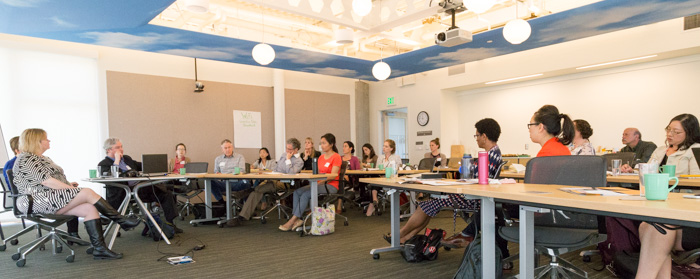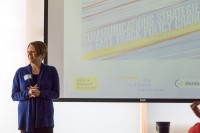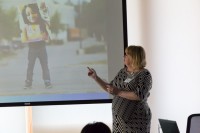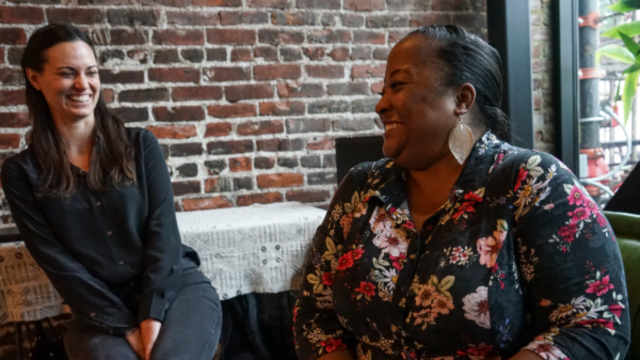Jon Stahl, Communications Director
In the past few days, we’ve hosted a pair of events with our friends at Media Impact Funders, the national network of grantmakers working on media and technology issues. In different ways, both touched on the power of communications — both medium and message — to drive forward the social change issues that animate philanthropy.
What's Next for the Internet
In “What’s Next for the Internet” we gathered at Philanthropy Northwest's headquarters for a conversation about this fast-changing landscape and the implications for grantmakers and grantees alike. The discussion featured Michael Copps, special advisor to Common Cause's Media and Democracy Reform Initiative and a former FCC Commissioner; June Wilson, executive director and board member at the Quixote Foundation; and Vince Stehle, executive director of Media Impact Funders.
Copps and Wilson described three recent media policy victories: 1) the FCC’s decision to protect open Internet access and to regulate broadband under Title II, aka “net neutrality;" 2) a related decision to stop the states from banning municipal broadband efforts; and 3) the demise of the proposed Comcast/TimeWarner merger.

All three of these campaigns, which generated millions of public comments, attention from President Obama and high-profile lobbying campaigns on both sides, showed that communications policies have become top-tier national issues after many years of public inattention. “The net neutrality vote,” said Copps, “was the most important FCC decision of this generation — and maybe ever. Had they gone in the other direction against net neutrality, we could have lost the heart of the Internet — perhaps irreparably."
Lots of decisions and questions about the future of the Internet remain, Copps and Wilson warned, including:
- Broadband deployment, especially in rural areas and for low-income communities. The FCC will soon begin the process of updating the regulations governing the Universal Service Fund, which currently supports the Lifeline program to subsidize landlines for low-income households. That process could begin as soon as June and will likely last 12-18 months. We were surprised to learn form Copps and Common Cause Director for Media and Democracy Todd O’Boyle that the top recipients of Lifeline subsidies are homeless veterans — a great illustration of the many points of intersection between media policy and other social issues.
- Political advertising disclosure. The FCC has the authority under Section 317 of the Telecommunications Act to compel disclosure of the funders of political advertising. According to Copps, this authority hasn't been revisited since the 1960s, and is ripe for updating, which could theoretically happen in time to affect the 2016 election cycle. Copps sees this as a key next step to promote transparency.
We also touched briefly upon other aspects of Internet and media policy, including:
- The idea that media policy is an issue that cuts across traditional issue silos. As Copps said, "No issues go anywhere without media access." Recent attention to media policy from Ford Foundation, Knight Foundation, Mozilla Foundation and Open Society Institute has been critical to getting these issues on the wider philanthropic sector radar.
- Intersections between media policy, the arts and artists. Martin Collier of the Glaser Progress Fund observed that surveillance and privacy are entry points for artists, as well as the role of media gatekeepers. As he reminded us, without privacy there is no creativity.
Communications Strategies That Fast Track Policy Change
The next day, we once again joined Vince Stehle, this time accompanied by Mary Lou Fulton, The California Endowment senior program manager, and Cassandra Stalzer, Rasmuson Foundation communications director, at the Wilbuforce Foundation for "Communications Strategies That Fast Track Policy Change. This discussion focused on successful communications/media investments by foundations, as collected in a recent report from the California Endowment, Hershey Cause Communications and Media Impact Funders.

Fulton walked us through the California Endowment's work on fixing school discipline practices in California, which has resulted 34% fewer suspensions since 2009-2010. In many ways, her disclaimer up front was one of my biggest take-home points: "This is looking in the rearview mirror," she said. "At the beginning we had no idea how this would unfold, and it wasn’t linear, really more of a controlled crash. You don’t have to know everything to start something."
 Key elements of their efforts included:
Key elements of their efforts included:
- A listening tour, which is how they first identified school discipline as an issue of concern to their communities.
- Research, both to define the problem and then to "name and frame" it.
- Op-eds that took advantage of the news hook provided by timely research emerging from Texas in 2011.
- A digital campaign hub to connect advocates across the state.
- Polling of both educators and the general public to demonstrate support for reform.
- Targeted TV advertising.
As Fulton summed up: Authentic issue + Clear Goals + People Power + Strategic Communications = Policy Change
 Stalzer then told us the story of Rasmuson Foundation's work with the Anchorage Daily News on its coverage of alcohol abuse in Alaska, a key element of Recover Alaska, a multi-sector project to reduce the impact of excessive alcohol consumption on Alaska communities, which costs an estimated $1.2 billion per year.
Stalzer then told us the story of Rasmuson Foundation's work with the Anchorage Daily News on its coverage of alcohol abuse in Alaska, a key element of Recover Alaska, a multi-sector project to reduce the impact of excessive alcohol consumption on Alaska communities, which costs an estimated $1.2 billion per year.
A key theme that emerged from Stalzer's story was the how important it is for foundations to embrace the risk that comes with funding journalism. Funders can't control the stories that get written and may have to manage reactions from communities or institutions that don't appreciate media attention. Trust between philanthropy and journalism is key, and foundations have to be brave enough to manage the consequences of investigative journalism.
A rich conversation then ensued, covering issues that included:
- The rapid evolution and diversity of media organizations, and the blurring lines between producers, subjects and consumers of media. More and more nonprofits are taking on "journalism" work.
- The intersection of evaluation, policy, data and media, and the ways that data can help validate and set the context for individual stories.
- The tension between short-term media projects and the often long-term nature of policy change. Communications can accelerate it, but by itself, it doesn't make change happen.
If you’d like to explore how advocacy can expand nonprofit impact, and what funders and nonprofit advisors can do to support stronger advocacy, than please join the Campion Foundation and Philanthropy Northwest on May 14 for a conversation with Anne Wallestad, CEO of BoardSource, about the new national campaign Stand for Your Mission.


